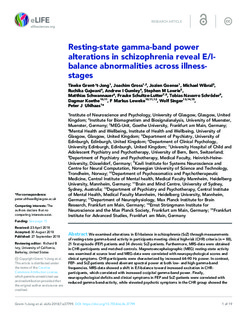Resting-state gamma-band power alterations in schizophrenia reveal E/I-balance abnormalities across illness-stages
Grent-’t-Jong, Tineke; Gross, Joachim; Goense, Jozien; Wibral, Michael; Gajwani, Ruchika; Gumley, Andrew I.; Lawrie, Stephen M.; Schwannauer, Matthias; Schultze-Lutter, Frauke; Navarro Schröder, Tobias; Koethe, Dagmar; Leweke, Markus; Singer, Wolf; Uhlhaas, Peter J.
Journal article, Peer reviewed
Published version
Permanent lenke
http://hdl.handle.net/11250/2617593Utgivelsesdato
2018Metadata
Vis full innførselSamlinger
Sammendrag
We examined alterations in E/I-balance in schizophrenia (ScZ) through measurements of resting-state gamma-band activity in participants meeting clinical high-risk (CHR) criteria (n = 88), 21 first episode (FEP) patients and 34 chronic ScZ-patients. Furthermore, MRS-data were obtained in CHR-participants and matched controls. Magnetoencephalographic (MEG) resting-state activity was examined at source level and MEG-data were correlated with neuropsychological scores and clinical symptoms. CHR-participants were characterized by increased 64–90 Hz power. In contrast, FEP- and ScZ-patients showed aberrant spectral power at both low- and high gamma-band frequencies. MRS-data showed a shift in E/I-balance toward increased excitation in CHR-participants, which correlated with increased occipital gamma-band power. Finally, neuropsychological deficits and clinical symptoms in FEP and ScZ-patients were correlated with reduced gamma band-activity, while elevated psychotic symptoms in the CHR group showed the opposite relationship. The current study suggests that resting-state gamma-band power and altered Glx/GABA ratio indicate changes in E/I-balance parameters across illness stages in ScZ.

